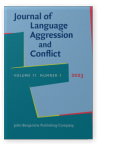Vol. 11:1 (2023) ► pp.101–120
Slang and verbal aggression
A morphopragmatic analysis of the compound families X-ass, X-brain, X-face, and X-head
While lexical and discourse strategies of hate speech have widely been studied hitherto, there is limited research devoted to the contribution of grammatical and morphological aspects to verbal aggression. This paper provides a corpus-assisted analysis of slang morphological means used in verbal aggression. The focus is on four compound families (X-ass, X-brain, X-face, X-head), which are often used in slang to form compound words referring to specific groups, such as homosexuals, fools, or ineffectual people. The paper adopts a morphopragmatic approach to investigate three pragmatic meanings/functions – namely, derisive, critical, and offensive – of slang words in situations of conflict. The combination of quantitative and qualitative analyses of data drawn from the Corpus of Contemporary American English (COCA) shows the frequency of the morphological processes, their privileged genres and contexts, as well as their negative potential and face-threatening power.
Article outline
- 1.Introduction
- 2.Theoretical background
- 3.Methodology and data
- 4.Compound constituents, combining forms, and affixoids
- 5.Analysis
- 5.1Quantitative analysis
- 5.1.1The constituent -ass
- 5.1.2The constituent -brain
- 5.1.3The constituent -face
- 5.1.4The constituent -head
- 5.2Qualitative analysis
- 5.2.1Derisive function
- 5.2.2Critical function
- 5.2.3Offensive function
- 5.1Quantitative analysis
- 6.General discussion and concluding remarks
- Notes
-
References
